I’ve been researching the history of Sunsoft for the past five years. During that time I’ve uncovered many of the mysteries surrounding Sunsoft. One of the biggest and best known of these Sunsoft mysteries was the fact that the NES game Journey to Silius was first developed as The Terminator, based on the 1984 hit film starring Arnold Schwarzenegger as the titular Terminator.
How was it known that Journey to Silius began as The Terminator? The evidence for this was the following:
- Sunsoft showed a game called The Terminator at the Winter Consumer Electronics Show (WCES) of 1989. One of the photos below shows a poster for The Terminator at the Sunsoft booth. The other two are of the flyer which was handed out at this event. It has been scanned and preserved and contains screenshots of the game.
- It was mentioned in the first issue of GamePro magazine which had coverage of WCES 89.
- Lastly there was also a short mention of the game in the July/August 1989 issue of Nintendo Power. The preview in “Pak Watch” also sported some screenshots of the game. These were not the same ones seen in the WCES 1989 flyer but rather screenshots that looked more like the game that we later would know as Journey to Silius. The walker mid-boss from the final game can be seen. Interestingly the player and stage graphics look different from Journey to Silius.
I reached out to everyone I could think of to ask about this game and what had happened. Sadly for awhile no one really seemed to know the fate of it. It took four years of research before the pieces finally started to fall in place. It began with Richard Robbins whose father Joseph Robbins (Better known as just Joe) had been an influential leader in the coin-op industry since the 1950s. Joe started out by being co-owner of Empire Distributing in Chicago before eventually becoming the president of coin-op at Atari in the early 1980s. He left Atari and then went on to co-founded a company called Kitco, later known as Kitkorp in 1984. As the name suggests, the company was selling kits for arcade games and mainly imported them from Japan. In 1986 Kitkorp was bought by Sun and renamed Sun Corporation of America, also called Sunsoft of America, or SOA for short. Joe was made president of Sunsoft of America after this but it was not his first time he had a connection to them. While at Atari he had actually helped license their arcade game Kangaroo to be distributed by Atari in the US.
Joe’s son Richard started at Sunsoft in 1986 and later became vice president before leaving in 1989. Richard was the first person I interviewed for my research and I have asked him about details now and then over the years. One day he sent me a picture of stuff he had found in his storage. There were some unfolded NES boxes, a Sunsoft mug, and two VHS tapes. I zoomed in on the labels on the tapes. And there it was. “Terminator”. The tape potentially had some sort of video footage of Sunsoft’s “The Terminator” on it so I was excited to say the least!
It took some months but Richard sent the tape to me. Lacking the equipment needed to digitize the tape I hired a local video guy to do it. After a couple of days he contacted me, telling me the tape stopped just a couple of minutes in. It seemed like the tape had some mechanical fault. I went to get what he had been able to digitize onto a USB drive. As soon as I got home I put the drive in my computer. The tape started off with a promo video for Fester’s Quest. I knew from the label that the second part was The Terminator and luckily it was still there and intact! The question still remained, what was this footage of? An early version of what became Journey to Silius, cut-scenes that had been cut from the game, or an entirely new game? Unfortunately, the tape started failing just seconds after the Terminator footage. And we didn’t get it to work later on either.
I wrote an article for the publication of the video, where I for the most part stated the facts that were known. But since then I have been able to talk to the main programmer and designer of the game, Masahito Nomura. Among Nomura’s most famous works is Journey to Silius and as main programmer on Hebereke, known as Ufouria: The Saga outside Japan.
And without further ado, here is the chronological development story of Sunsoft’s The Terminator.
In 1988, vice president of Sunsoft of America, Richard Robbins, acquired the license for James Cameron’s 1984 hit movie The Terminator. The license was acquired from Creative Licensing Corporation (CLC) and its founder Rand Marlis. Even though the movie was four years old at the time, they felt the license still had some life in it. Three years later in 1991 that was shown to be true when Terminator 2: Judgement Day became a hit in theaters around the world. It seems that Richard Robbins had a nose for what older licenses would become popular again. Another example of this is in 1988 Robbins also licensed the old TV show Addams Family to make Fester’s Quest. This game was released for the Nintendo Entertainment System three years before the movie The Addams Family hit theaters to great success. Last but not least he was involved in securing the license for the upcoming Batman movie in 1989. Until that movie became a blockbuster hit Batman was another brand that had faded from the public consciousness outside of comic book fans for the most part.
The development of the Terminator game was left to Sunsoft’s development staff in Japan, with no design input from the US office. The programming team was headed by veterans Masahito Nomura and Hiroaki Higashiya. Both had started at Sun Electronics in the early 1980s and been there when the company started its Family Computer development in 1985. On the sound team were sound programmers Nobuyuki Hara and Shinichi Seya, who coded most of the great Sunsoft music of the 8-bit era. The composer was Naoki Kodaka, who composed most of the company’s music between 1985 and 1996. The producers were Hiroyasu Eguchi and Sunsoft’s manager Kiharu Yoshida.
The development of the game started some time in late 1988. As mentioned earlier Nomura and the team set out to make a game in the style of Cinematronics’ popular laserdisc arcade game Dragon’s Lair. In Dragon’s Lair and its spiritual sequel, Space Ace, the laserdisc medium was used to show animated cartoon clips and then at certain points allow the player to choose what to do next. Based on the choice the game would continue or the game’s hero would meet his end. The games were animated by famous American animator Don Bluth.
A game of that style would obviously be hard to make on the Family Computer since it would require lots of unique graphics to make up all the animated scenes. The graphics of course would not be cartoon animations. Rather they would be like cut scenes used in other Famicom and NES games of the time, but with interactive points where the player could decide what to do next.
The team had to adhere to some severe restrictions in making the game, dictated by the license holder, CLC. The Terminator could not die at any time other than at the end of the game, just like Arnold Schwarzenegger’s robotic character in the movie. And there could be no enemy characters other than the Terminator in the game. The “Dragon’s Lair” style of game makes this much more feasible that an action game would, focusing on the story rather than on action that requires multiple enemies. Having the Terminator chase the player through scenes from the movie.
At the Las Vegas Winter Consumers Electronics Show in January 1989, Sunsoft of America unveiled The Terminator for the NES. A cool flyer with the iconic picture of Arnold Schwarzenegger as the T-800 was shown along with a promotional video for the game. Artist Todd Papaleo, who worked at Sunsoft from 1988 to 1989, sent us a drawing he had been assigned to draw of T-800. It was for the promo video to be shown at CES. Todd was given less than 24 hours to come up with the pictures for the video.
Let’s watch the promo video.
The promo video includes several scenes from the game that are approximations of scenes from the movie.
- The Police station scene.
- The truck chase scene.
- Terminator/Kyle Reese arriving from the future.
As mentioned, the Dragon’s Lair style game would need a large amount of graphics. Graphics take up memory and memory was very expensive at the time. Due to the ambitious plans of putting this type of game on a cartridge, they quickly ran out of memory. Nomura says that they were not able to make a full-length game with the available memory. The managers did not want to spend any more money on memory for the game so the original plans were scrapped and the team was forced to start over. This first attempt of making Terminator into a Dragon’s Lair type game was in development for about three or four months.
They started making an action game instead that would fit within the limitations of the allowed memory. But the change of genre also made it impossible to adhere to the license holder’s requirements. So, Nomura and his team set the game in the future where the player more logically could fight off other enemies before meeting the Terminator.
Later that year, a finished build of the game was presented for Rand Marlis at CLC. Rand says they revoked the license because the game did not follow the plot of the original film. The movie is mainly set in the present day (1984) while the game is set in the future where the artificial intelligence Skynet has taken control of the Earth with an army of robots. Rand tells me it was unusual to not show them anything until a product is finished. It was more common to first come to CLC with a concept to show what you are going to do and to see if it is within the parameters they would accept.
To be fair, in the late 80s it was a very difficult design task to make a game that could not include more than one enemy, and that enemy could not die until the end, and Nomura knew it. They were fully aware that the game was not going to pass the requirements. So they just focused on making a good action game that was at least set in the universe of the movie. Nomura is a bit disappointed that he didn’t get to finish it as a Terminator game, but glad that it is a game that is considered a classic for the NES.
After losing the license, Sunsoft decided to rename the game and replace all its cut-scenes instead of scrapping the whole game. At first the game was called Operation S.S.S. for the US market. It was listed as Operation S.S.S. as late as WCES 1990, and was scheduled for a June 1990 release. The title Operation S.S.S. had been known since 2009 when the content of Sunsoft dev disks was posted on the Lost Levels forum. Among the things found on the disks was the title screen assets for Operation S.S.S.
Sometime after this, the name was changed once again to Journey to Silius. Nomura recalls that it was producer Hiroyasu Eguchi who came up with that name. It was released as Rough World (Stylized as [rʌf] WORLD) in Japan, and Eguchi was responsible for this final title as well. Unfortunately Eguchi was killed in a car accident some years later, so how he came up with these names will probably remain unknown. The game we now know as Journey to Silius took about a year to make but was delayed a bit after losing the Terminator license.
I asked composer Naoki Kodaka about the music in the game. He tells me that he composed the music for The Terminator. After the name change he didn’t do any additional compositions for it, so we can assume that the music is the same as for the Terminator game. Kodaka speculated that it was possible that Nobuyuki Hara may have rearranged the music but that it probably was the same as before.
Somehow, the Terminator rights were later picked up by Canadian developer Radical Entertainment, who would eventually make a game for the series that was released in 1992. Virgin Games also had plans for a Terminator NES game in between Sunsoft and Radical’s attempts, according to an interview with programmer Gregg Tavares. For some reason Radical’s game could have all sorts of enemies besides the Terminator, including several other Terminators. But one of these seemingly identical Terminators meets its end just like Arnold in the movie, and the game is set in present day 1984. Making a rushed game that adhered more to the license holder’s requirements rather than making a good game was common with licensed games. It was the main reason why so many licensed games were bad. Despite this, Sunsoft would manage to develop two of the best licensed games of all time. Both Batman: The Video Game and Gremlins 2: The New Batch for NES are great games that in some fashion follow the story of the movies they are based on. But they most importantly was good games, because Sunsoft wanted to make great games more than they wanted to follow the license holders guidelines.

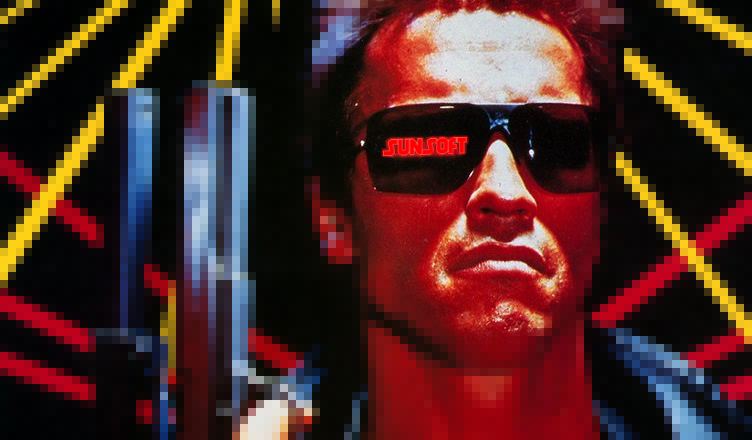
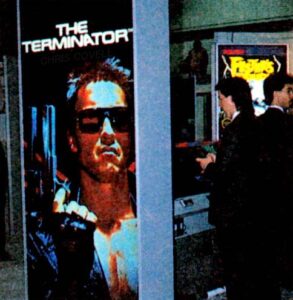
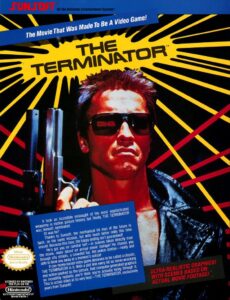
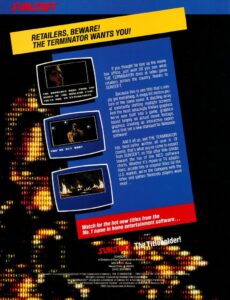
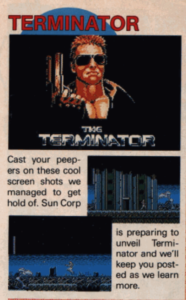
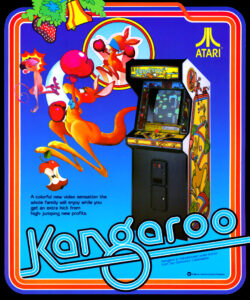
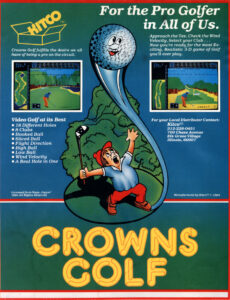
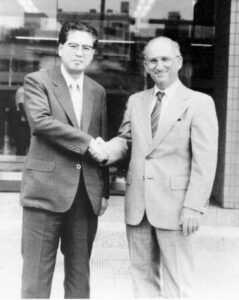
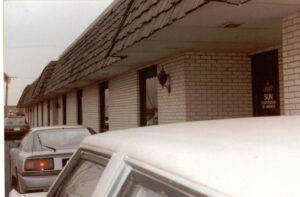
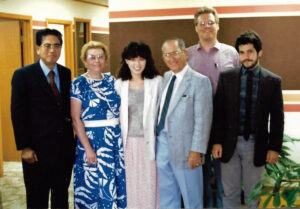
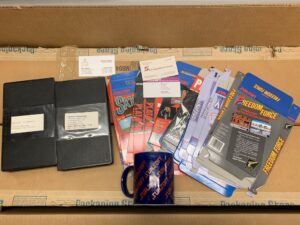
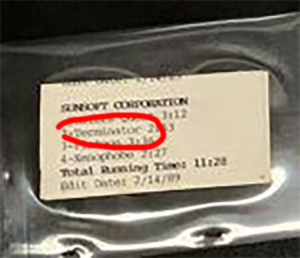
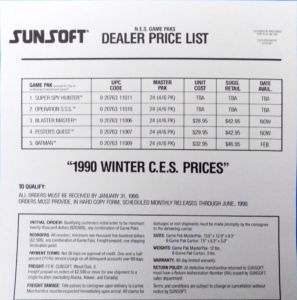
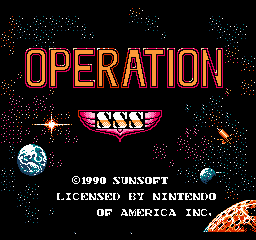
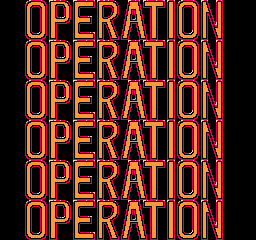
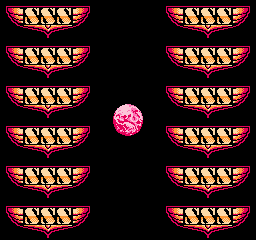





I have both original dealer posters for Batman and Terminator from the 89 CES show. Looks like the one in the article. I hope someone finds the game at some point. It would have been a classic.